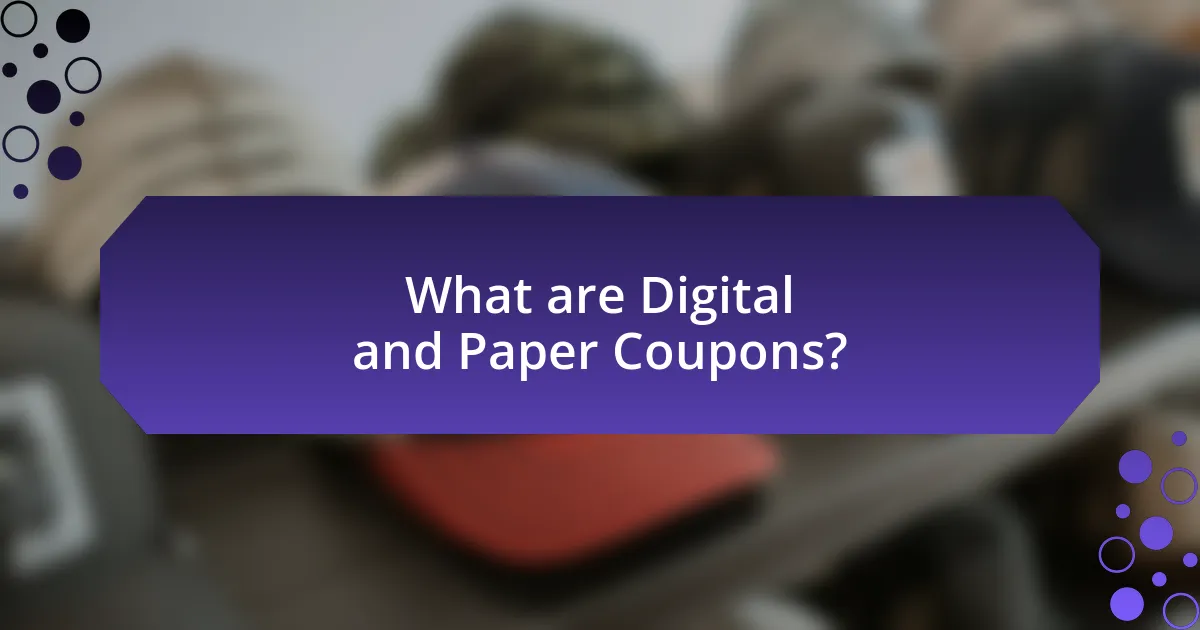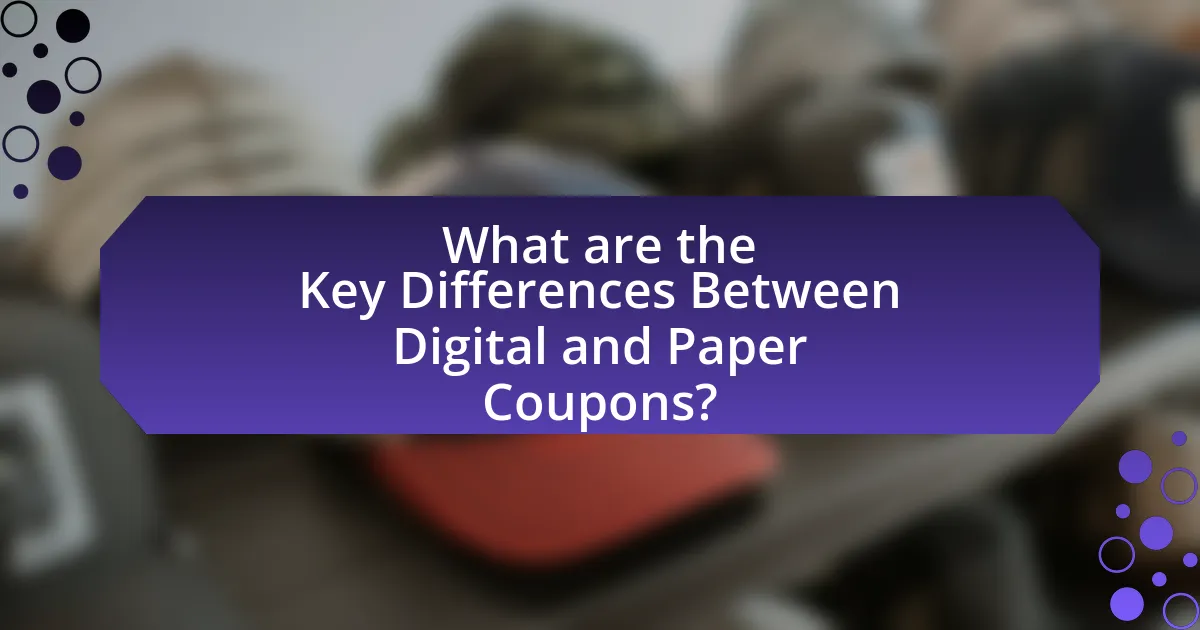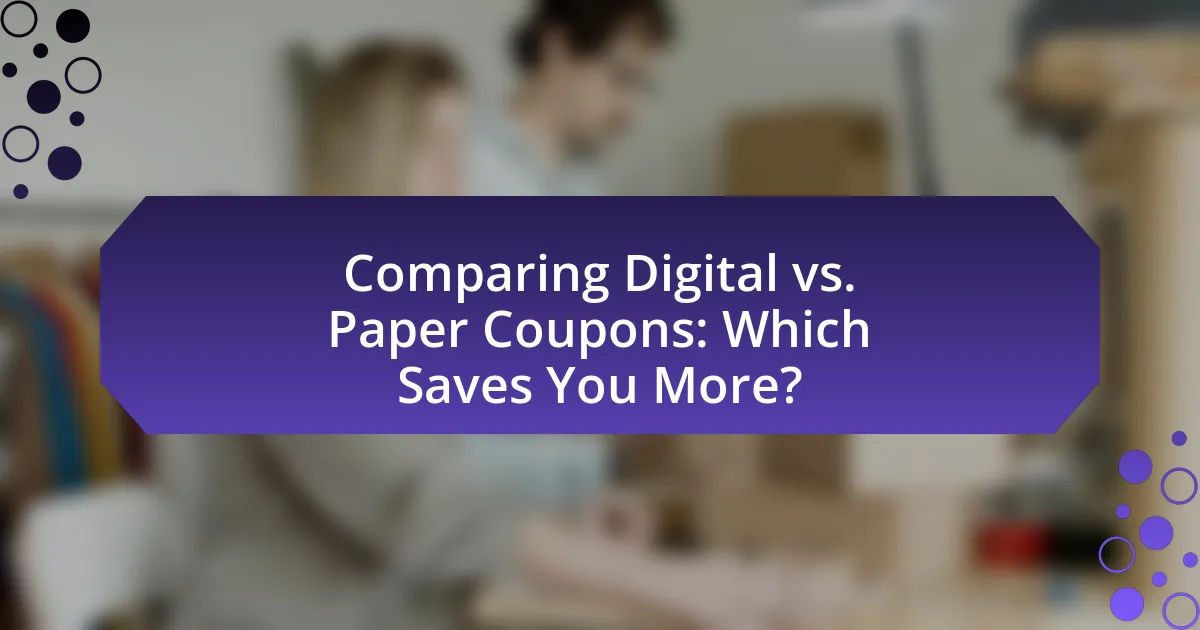The article compares digital and paper coupons, examining their definitions, functionalities, and advantages. Digital coupons are electronic vouchers that can be redeemed online or via mobile devices, while paper coupons are physical vouchers presented at the point of sale. The article highlights the growing preference for digital coupons due to their convenience, higher redemption rates, and potential for greater savings, as well as the continued relevance of paper coupons for consumers who prefer traditional methods. Key differences, user experiences, and strategies for maximizing savings with both types of coupons are also discussed, providing a comprehensive overview of how each format impacts consumer behavior and savings potential.

What are Digital and Paper Coupons?
Digital coupons are electronic vouchers that provide discounts or promotions and can be redeemed online or through mobile devices. Paper coupons, on the other hand, are physical pieces of paper that offer similar discounts and must be presented at the point of sale. Both types of coupons serve the same purpose of reducing the cost of purchases, but they differ in their format and method of redemption. Digital coupons have gained popularity due to their convenience and ease of use, with a report from the Digital Couponing Study indicating that 80% of consumers prefer digital formats for their accessibility and instant application.
How do Digital Coupons work?
Digital coupons work by providing consumers with discounts or promotional offers that can be redeemed electronically, typically through a smartphone app or website. Users can access these coupons by downloading them directly to their devices or receiving them via email or text message. When making a purchase, customers present the digital coupon at checkout, either by scanning a barcode or entering a code, which automatically applies the discount to their total. Research indicates that digital coupons are increasingly popular, with a 2021 study by the National Retail Federation showing that 97% of consumers have used a digital coupon, highlighting their effectiveness in driving sales and customer engagement.
What platforms offer Digital Coupons?
Platforms that offer digital coupons include major retailers and grocery chains such as Target, Walmart, and Kroger, as well as coupon-specific websites and apps like RetailMeNot, Honey, and Coupons.com. These platforms provide users with access to a variety of digital coupons that can be redeemed online or in-store, often featuring exclusive deals and discounts. For example, RetailMeNot reported that users can save an average of 20% on their purchases by utilizing digital coupons available on their site.
What are the advantages of using Digital Coupons?
Digital coupons offer several advantages, including convenience, accessibility, and enhanced savings. They can be easily stored on smartphones or apps, eliminating the need for physical storage and reducing the likelihood of loss. According to a study by the Digital Coupon Association, digital coupons are redeemed at a rate of 10-20% higher than paper coupons, indicating that consumers are more likely to use them. Additionally, digital coupons often provide personalized offers based on shopping behavior, leading to more relevant savings for users. This personalization can increase customer loyalty and engagement, further enhancing the value of digital coupons.
How do Paper Coupons work?
Paper coupons work by providing a discount or promotional offer that consumers can redeem at the point of sale. When a customer presents a paper coupon to a cashier, the cashier scans or manually enters the coupon code, which deducts the specified amount from the total purchase price. According to a study by the Coupon Information Corporation, approximately 90% of consumers still use paper coupons, indicating their continued relevance in retail. This method allows retailers to track coupon usage and measure the effectiveness of their promotional campaigns.
Where can you find Paper Coupons?
Paper coupons can be found in several locations, including newspapers, magazines, and direct mail advertisements. Many grocery stores and retailers also distribute paper coupons at their locations or through promotional events. Additionally, some manufacturers provide paper coupons on their product packaging or through in-store displays. These sources are reliable for obtaining paper coupons that can be used for discounts on various products.
What are the advantages of using Paper Coupons?
Paper coupons offer several advantages, including tangible savings, ease of use, and accessibility. They provide immediate discounts at the point of sale, allowing consumers to save money directly on their purchases. Additionally, paper coupons do not require internet access or smartphone technology, making them accessible to individuals who may not be tech-savvy or who prefer traditional shopping methods. According to a study by the Coupon Information Corporation, paper coupons accounted for approximately 92% of all coupon redemptions in 2020, highlighting their continued popularity and effectiveness in driving consumer savings.

What are the Key Differences Between Digital and Paper Coupons?
Digital coupons are accessed and redeemed electronically, while paper coupons are physical, printed vouchers. Digital coupons often require a smartphone or computer for access, enabling instant updates and tracking, whereas paper coupons must be physically presented at the point of sale. Additionally, digital coupons can be personalized based on user preferences and shopping habits, while paper coupons typically offer a one-size-fits-all discount. According to a 2021 report by the Coupon Information Corporation, digital coupon usage has increased by 30% over the past five years, indicating a shift towards electronic formats due to convenience and accessibility.
How do the savings compare between Digital and Paper Coupons?
Digital coupons generally offer higher savings compared to paper coupons. Research indicates that digital coupons can provide discounts averaging 15% to 20% off, while paper coupons typically yield savings of around 5% to 10%. Additionally, a study by the Coupon Information Corporation found that digital coupons are redeemed at a rate of 10 times higher than paper coupons, leading to greater overall savings for consumers. This trend is attributed to the convenience and accessibility of digital platforms, which encourage more frequent use and higher-value offers.
What factors influence the savings from each type of coupon?
The savings from each type of coupon are influenced by factors such as the coupon’s face value, redemption rate, and the consumer’s purchasing behavior. The face value determines the maximum discount available, while the redemption rate reflects how often consumers actually use the coupons, which can vary significantly between digital and paper formats. For instance, a study by the Promotion Marketing Association found that digital coupons have a higher redemption rate, averaging around 10% compared to 1% for paper coupons, leading to greater overall savings for consumers who prefer digital options. Additionally, consumer behavior, including the frequency of shopping and the types of products purchased, also affects the savings realized from each coupon type.
Are there any hidden costs associated with either type of coupon?
Yes, there can be hidden costs associated with both digital and paper coupons. For digital coupons, users may incur data charges if they access them via mobile devices, and some retailers may require a minimum purchase amount to redeem the coupon, which can lead to spending more than intended. In the case of paper coupons, consumers might face costs related to printing or the time spent searching for and organizing them, as well as potential expiration dates that can lead to wasted savings if not used in time. These factors indicate that while coupons can provide savings, they may also come with additional expenses that consumers should consider.
What are the user experiences with Digital vs. Paper Coupons?
User experiences with digital coupons generally indicate higher convenience and ease of use compared to paper coupons. Digital coupons can be easily accessed on smartphones, allowing users to quickly apply discounts at checkout without the need for physical handling. In contrast, paper coupons often require users to remember to bring them, which can lead to missed savings. A survey conducted by the Coupon Information Corporation found that 80% of respondents preferred digital coupons for their accessibility and instant application, while only 30% reported consistently using paper coupons. This data highlights a significant shift in user preference towards digital formats due to their practicality and efficiency.
How do users perceive the convenience of each coupon type?
Users perceive digital coupons as more convenient than paper coupons due to their accessibility and ease of use. Digital coupons can be stored on smartphones, eliminating the need to carry physical copies, which often leads to forgetting or losing them. A survey conducted by the National Retail Federation found that 72% of consumers prefer digital coupons for their instant availability and the ability to apply them directly at checkout, enhancing the shopping experience. In contrast, paper coupons require physical handling and can be cumbersome, leading to a perception of inconvenience among users.
What challenges do users face with Digital Coupons?
Users face several challenges with digital coupons, including technical issues, limited acceptance, and user interface difficulties. Technical issues such as app crashes or slow loading times can hinder the coupon redemption process, leading to frustration. Limited acceptance occurs when not all retailers or brands accept digital coupons, restricting users’ ability to utilize them effectively. Additionally, user interface difficulties, such as complicated navigation or unclear instructions, can make it challenging for users to find and apply their coupons, ultimately reducing their overall savings experience.

How Can You Maximize Savings with Coupons?
To maximize savings with coupons, utilize a combination of digital and paper coupons strategically. Digital coupons often provide instant savings and can be easily accessed through apps or websites, while paper coupons can sometimes offer higher discounts or be stacked with store promotions. According to a study by the Coupon Information Corporation, consumers can save an average of $1.44 for every coupon redeemed, highlighting the effectiveness of using coupons in general. Additionally, tracking expiration dates and combining coupons with sales can further enhance savings, making it essential to stay organized and informed about available offers.
What strategies can you use to effectively use Digital Coupons?
To effectively use digital coupons, consumers should first organize their coupons by expiration dates and store them in a dedicated app or digital wallet for easy access. This strategy ensures that users do not miss out on savings due to expired offers. Additionally, consumers should combine digital coupons with sales and promotions to maximize their savings; for instance, using a digital coupon on a sale item can lead to significant discounts. Research indicates that shoppers who strategically stack coupons with sales can save up to 50% on their purchases. Lastly, subscribing to retailer newsletters can provide exclusive digital coupons and alerts about upcoming sales, further enhancing savings opportunities.
How can you combine Digital Coupons with other discounts?
You can combine digital coupons with other discounts by applying them during checkout when the retailer’s policy allows stacking. Many retailers permit the use of a digital coupon alongside store sales, loyalty program discounts, or manufacturer coupons, maximizing savings. For example, if a store offers a 20% off sale and you have a digital coupon for an additional $5 off, you can apply both to reduce your total cost significantly. Retailers often specify their stacking policies, so checking the terms and conditions is essential to ensure compliance and maximize savings.
What are the best apps for finding Digital Coupons?
The best apps for finding digital coupons include Honey, Rakuten, and RetailMeNot. Honey automatically applies coupon codes at checkout for various online retailers, making it easy for users to save money without extensive searching. Rakuten offers cashback on purchases along with access to coupons, providing an additional incentive for users to shop through their platform. RetailMeNot aggregates coupons from numerous retailers, allowing users to browse and find deals conveniently. These apps are widely recognized for their effectiveness in helping consumers save money through digital coupons.
What strategies can you use to effectively use Paper Coupons?
To effectively use paper coupons, organize them by category and expiration date to maximize savings. This strategy allows consumers to quickly identify relevant coupons when shopping, ensuring they do not miss out on discounts. Additionally, pairing paper coupons with sales or promotions can amplify savings; for instance, using a coupon on a sale item can lead to significant reductions in total costs. Research indicates that shoppers who strategically combine coupons with in-store promotions save an average of 20% more than those who do not. Furthermore, keeping track of store policies regarding coupon stacking can enhance savings opportunities, as some retailers allow the use of multiple coupons on a single item.
How can you organize and track Paper Coupons for maximum savings?
To organize and track paper coupons for maximum savings, categorize them by expiration date, store, or product type. This method allows for easy access and ensures that you utilize the coupons before they expire. For instance, placing coupons in a binder with labeled sections can help you quickly find the relevant coupons when shopping. Additionally, maintaining a digital list or spreadsheet of your coupons, including their expiration dates and the stores where they can be used, enhances tracking efficiency. Research indicates that organized couponing can lead to savings of up to 50% on grocery bills, demonstrating the effectiveness of a structured approach.
What are the best resources for finding Paper Coupons?
The best resources for finding paper coupons include local newspapers, coupon websites, and retail stores. Local newspapers often feature weekly coupon inserts, providing a variety of discounts on groceries and household items. Coupon websites like Coupons.com and RetailMeNot aggregate printable coupons from various brands, allowing users to access a wide range of offers. Additionally, many retail stores have in-store coupon books or flyers that contain exclusive paper coupons for their customers. These resources are widely recognized for their effectiveness in helping consumers save money through paper coupons.
Which type of coupon is better for specific shopping scenarios?
Digital coupons are generally better for specific shopping scenarios, particularly for frequent shoppers and those seeking convenience. Digital coupons can be easily accessed through mobile apps or websites, allowing users to apply discounts at checkout without the need for physical handling. According to a study by the Coupon Information Corporation, digital coupons have seen a 30% increase in usage over the past five years, indicating a growing preference for their convenience and ease of use. In contrast, paper coupons may be more beneficial for shoppers who prefer tangible items or those who do not have access to smartphones or the internet. However, the overall trend shows that digital coupons provide greater flexibility and savings opportunities in various shopping contexts.



